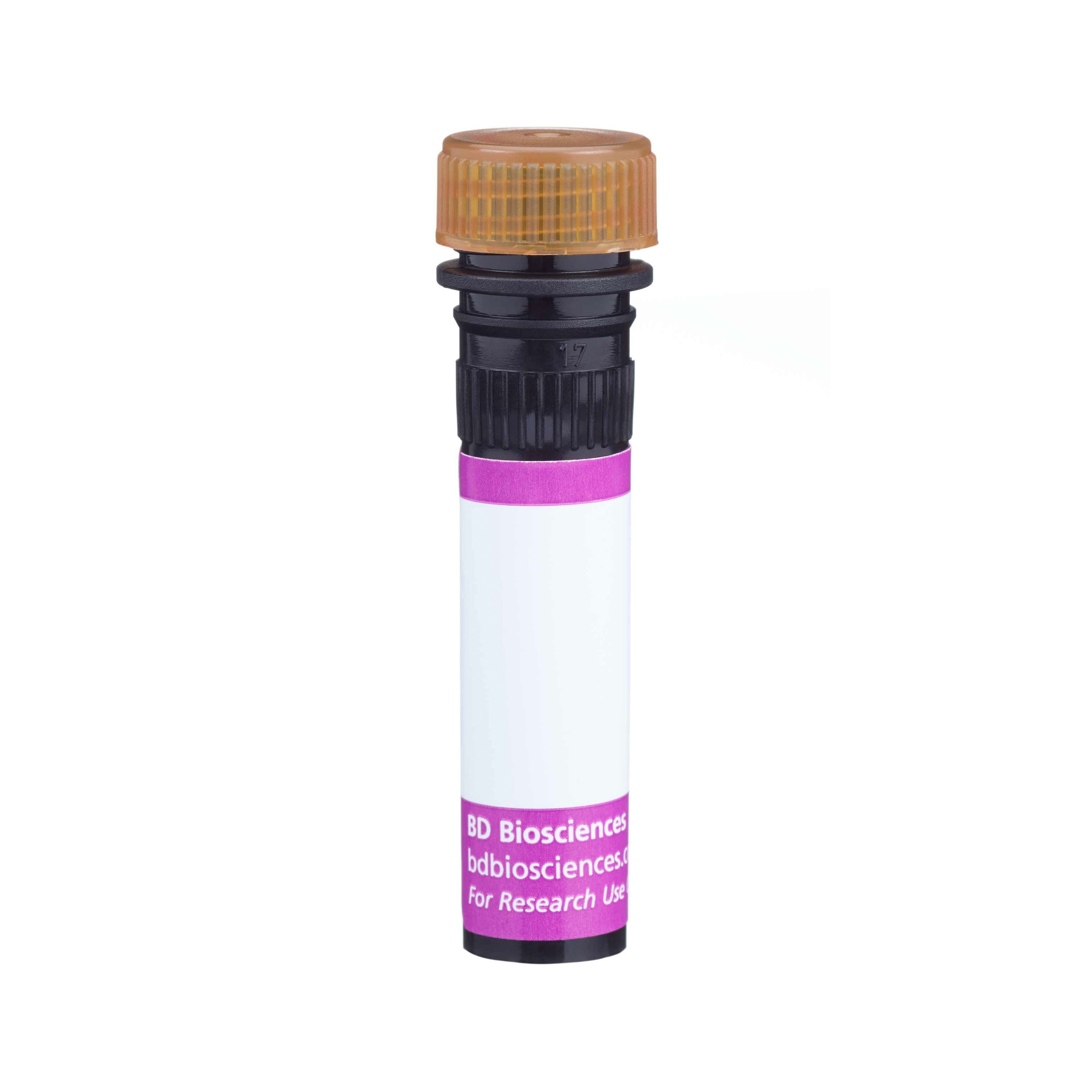Old Browser
Looks like you're visiting us from United States.
Would you like to stay on the current country site or be switched to your country?
BD OptiBuild™ BV786 Mouse Anti-Human TIM-3 (CD366)
克隆 7D3 (RUO)


监管状态图例
未经BD明确书面授权,严禁使用未经许可的任何商品。
准备和存储
推荐的实验流程
For optimal and reproducible results, BD Horizon Brilliant Stain Buffer should be used anytime two or more BD Horizon Brilliant dyes (including BD OptiBuild Brilliant reagents) are used in the same experiment. Fluorescent dye interactions may cause staining artifacts which may affect data interpretation. The BD Horizon Brilliant Stain Buffer was designed to minimize these interactions. More information can be found in the Technical Data Sheet of the BD Horizon Brilliant Stain Buffer (Cat. No. 563794).
商品通知
- This antibody was developed for use in flow cytometry.
- The production process underwent stringent testing and validation to assure that it generates a high-quality conjugate with consistent performance and specific binding activity. However, verification testing has not been performed on all conjugate lots.
- Researchers should determine the optimal concentration of this reagent for their individual applications.
- An isotype control should be used at the same concentration as the antibody of interest.
- Caution: Sodium azide yields highly toxic hydrazoic acid under acidic conditions. Dilute azide compounds in running water before discarding to avoid accumulation of potentially explosive deposits in plumbing.
- For fluorochrome spectra and suitable instrument settings, please refer to our Multicolor Flow Cytometry web page at www.bdbiosciences.com/colors.
- Please refer to www.bdbiosciences.com/us/s/resources for technical protocols.
- BD Horizon Brilliant Stain Buffer is covered by one or more of the following US patents: 8,110,673; 8,158,444; 8,575,303; 8,354,239.
- BD Horizon Brilliant Violet 786 is covered by one or more of the following US patents: 8,110,673; 8,158,444; 8,227,187; 8,455,613; 8,575,303; 8,354,239.
- Cy is a trademark of GE Healthcare.
数据表
配套商品






The 7D3 monoclonal antibody specifically binds to T cell immunoglobulin mucin 3 (TIM-3) which is also known as, CD366, or T-cell immunoglobulin and mucin domain-containing protein 3 (TIMD-3/TIMD3). CD366 is encoded by the HAVCR2 gene (Hepatitis A virus cellular receptor 2). CD366 is a type I transmembrane glycoprotein and belongs to the human TIM family (along with TIM-1 and TIM-4) within the immunoglobulin superfamily. CD366 is expressed on Th1, Tc1, Th17, Treg, NK T, and NK cells. CD366 is also expressed on dendritic cells, mast cells, monocytes, and macrophages. It is not expressed by Th2 and B cells. CD366 helps maintain peripheral immune tolerance and homeostasis. CD366 regulates macrophage activation and is a negative regulator of Th1 cell function. Crosslinking of cell surface CD366 by binding to Galectin-9 and/or phosphatidylserine appears to play an important role in either positively or negatively regulating leucocyte functions, such as cytokine production or the phagocytosis of apoptotic cells. CD366 may also be useful as an AML stem cell surface marker because it appears to be more highly expressed by AML leukemia stem cells than by normal bone marrow hematopoietic stem cells.
The antibody was conjugated to BD Horizon™ BV786 which is part of the BD Horizon Brilliant™ Violet family of dyes. This dye is a tandem fluorochrome of BD Horizon BV421 with an Ex Max of 405-nm and an acceptor dye with an Em Max at 786-nm. BD Horizon BV786 can be excited by the violet laser and detected in a filter used to detect Cy™7-like dyes (eg, 780/60-nm filter).

研发参考 (12)
-
Domenig C, Zheng XX, Sabatos CA, et al. Tim-3 inhibits T helper type 1-mediated auto- and alloimmune responses and promotes immunological tolerance. Nat Immunol. 2003; 4(11):1093-1101. (Biology). 查看参考
-
Freeman GJ, Casasnovas JM, Umetsu DT, DeKruyff RH. TIM genes: a family of cell surface phosphatidylserine receptors that regulate innate and adaptive immunity.. Immunol Rev. 2010; 235(1):172-89. (Biology). 查看参考
-
Hafler DA, Kuchroo V. TIMs: Central regulators of immune responses. J Exp Med. 2008; 205:2699-2701. (Biology). 查看参考
-
Jan M, Chao MP, Cha AC, et al. Prospective separation of normal and leukemic stem cells based on differential expression of TIM3, a human acute myeloid leukemia stem cell marker. Proc Natl Acad Sci U S A. 2011; 108(12):5009-5014. (Biology). 查看参考
-
Khademi M, Illes Z, Gielen AW, et al. T Cell Ig- and mucin-domain-containing molecule-3 (TIM-3) and TIM-1 molecules are differentially expressed on human Th1 and Th2 cells and in cerebrospinal fluid-derived mononuclear cells in multiple sclerosis. J Immunol. 2004; 172(11):7169-7176. (Biology). 查看参考
-
Lee J, Su EW, Zhu C, et al. Phosphotyrosine-dependent coupling of Tim-3 to T-cell receptor signaling pathways. Mol Cell Biol. 2011; 31(19):3963-3974. (Biology). 查看参考
-
Lee JS, Park MJ, Park S, Lee ES. Differential expression of T cell immunoglobulin- and mucin-domain-containing molecule-3 (TIM-3) according to activity of Behcet's disease. Br J Dermatol. 2012; 65(3):220-222. (Biology). 查看参考
-
Moorman JP, Wang JM, Zhang Y, et al. Tim-3 pathway controls regulatory and effector T cell balance during hepatitis C virus infection. J Immunol. 2012; 189(2):755-766. (Biology). 查看参考
-
Ndhlovu LC, Lopez-Verges S, Barbour JD, et al. Tim-3 marks human natural killer cell maturation and suppresses cell-mediated cytotoxicity. Blood. 2012; 119(16):3734-3743. (Biology). 查看参考
-
Rodriguez-Manzanet R, DeKruyff R, Kuchroo VK, Umetsu DT. The costimulatory role of TIM molecules. Immunol Rev. 2009; 229(1):259-270. (Biology). 查看参考
-
Wang F, Wan L, Zhang C, Zheng X, Li J, Chen ZK. Tim-3-Galectin-9 pathway involves the suppression induced by CD4+CD25+ regulatory T cells. Immunobiology. 2009; 214(5):342-349. (Biology). 查看参考
-
van de Weyer PS, Muehlfeit M, Klose C, Bonventre JV, Walz G, Kuehn EW. A highly conserved tyrosine of Tim-3 is phosphorylated upon stimulation by its ligand galectin-9. Biochem Biophys Res Commun. 2006; 351(2):571-576. (Biology). 查看参考
Please refer to Support Documents for Quality Certificates
Global - Refer to manufacturer's instructions for use and related User Manuals and Technical data sheets before using this products as described
Comparisons, where applicable, are made against older BD Technology, manual methods or are general performance claims. Comparisons are not made against non-BD technologies, unless otherwise noted.
For Research Use Only. Not for use in diagnostic or therapeutic procedures.